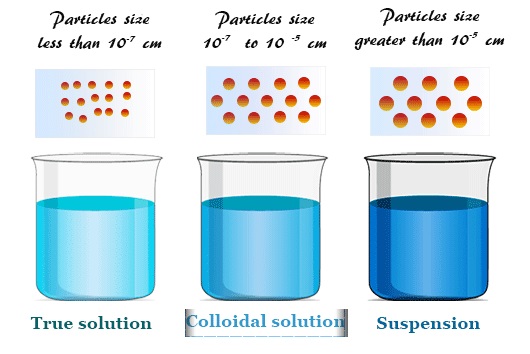Colloidal Solution:
Thomas Graham in 1861 observed that certain solute such as starch, gelatin, etc. could not pass through the parchment membrane while the ordinary solutes such as sodium chloride, urea, sugar, etc. can easily do so. The former solutes is called colloids (Greek, kolla meaning glue) while the latter were called crystalloids. However, the above classification of solutes into crystalloids and colloids proved unsatisfactory because a particular substance would be crystalloid in one solvent and a colloidal in the other. For example in aqueous solution, NaCl is a crystalloid, while in benzene, it behaves as colloid. Further studies of the behaviour of these solutes have shown that the nature of the substance whether colloid or crystalloid depends upon the particle size. When the size of the particles is between 1 nm to 100 nm, it behaves like a colloid and in case, it is less than this range, it gives the characteristics of crystalloid. Thus, colloid is not a substance but it is a state of a substance which depends upon the molecular size.
Three Types of Solutions:
On the basis of particle size of the substance, the solutions maybe divided into three types. These are:
- True solutions
- Suspensions
- Colloidal solutions
True solutions:
True solution is a homogeneous solution which contains solute particles (molecules or ions) dispersed throughout a solvent. e.g. aqueous solution of sodium chloride. The particle size is less than 1 nm.
Suspension:
Suspension is a heterogeneous mixture which contains small insoluble particles. The particle size is more than 100 nm. e.g. dirt particles in water.
Colloidal solutions:
Colloidal solution is a heterogeneous solution which contains particles of intermediate size. For example, milk. The particles of a colloidal solution have diameters between 1 to 100 nm. Such particles cannot be normally seen with a naked eye. However, light reflected by them can be seen under an ultra-microscope. The particles of a colloidal solution can pass through ordinary filter paper but not through animal membrane.
Phases of Colloidal System:
A colloidal solution is of heterogeneous and consists of two phases i.e. a dispersed phase and a dispersion medium. The third phase can be stabilizing agent.
1) Dispersed phase: It is the component present in small proportion and is just like a solute in a solution. e.g. in the colloidal solution of silver in water, the former acts as a dispersed phase.
2) Dispersion medium: It is the component present in excess and is just like a solvent in a solution. In the above example, water acts as a dispersion medium.
Lyophilic and Lyophobic Colloids:
Depending upon the nature of interactions between dispersed phase and the dispersion medium, the colloidal solutions are two types- lyophilic and lyophobic sols.
1) Lyophilic Colloids:
The colloidal solutions, in which the particles of the dispersed phase have a great affinity (or love) for the dispersion medium, are called lyophilic colloids. These solutions are easily formed and the lyophilic colloids are reversible in nature. In case water acts as the dispersion medium, the lyophilic colloid is called hydrophilic colloid. The common examples of lyophilic colloids are glue, gelatin, starch, proteins, rubber, etc.
2) Lyophobic Colloids:
The colloidal solutions in. which there is no affinity (or love rather they have hatred) between particles of the dispersed phase and the dispersion medium are called lyophobic colloids. Such solutions are formed with difficulty. These are irreversible in nature. In case, the dispersion medium is water, the lyophobic sol is called hydrophobic colloid. For example, the solutions of metals like Ag and Au, hydroxides like Al(OH)3, Fe (OH)3, metal sulphides like As2S3 etc.

Protection Colloids:
The process of protecting the lyophobic colloidal solutions from precipitation by the electrolytes due to the previous addition of some lyophilic colloid is called protection. The colloid which is added to prevent coagulation of the colloidal sol is called protecting colloid. The protecting power of different protective (lyophilic) colloids is expressed in terms of gold number.
Gold Number:
Gold number defined as the minimum amount of the protective colloid in milligrams required to just prevent the coagulation of a 10 ml of a given gold sol when 1 ml of a 10% solution of sodium chloride is added to it. It may be noted that smaller the value of gold number, greater will be protecting power of the protective colloids. Therefore, reciprocal of gold number is the measure of the protective power of a colloid.